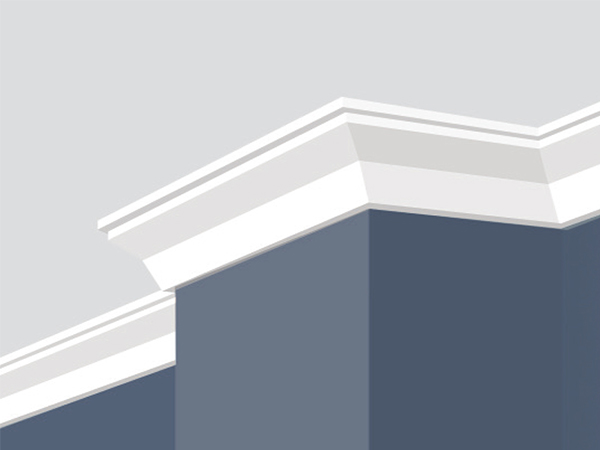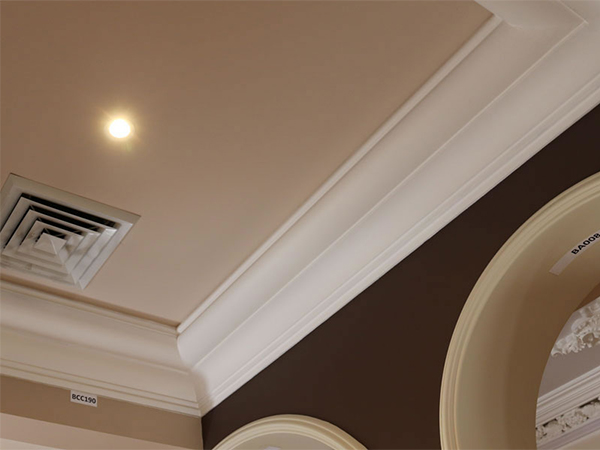Cornice
What is a cornice?
In architecture, a cornice is generally any horizontal decorative moulding that crowns a building or furniture element – the cornice coving over a door or window, for instance, or the cornice around the top edge of a pedestal or linear along the top of an interior wall. A simple cornice may be formed just with a crown, as in crown molding atop an interior wall or above kitchen cabinets or a bookcase.
What is its purpose?
A projecting cornice on a building has the function of throwing rainwater free of the building's walls. In residential building practice, this function is handled by projecting gable ends, roof eaves, and gutters. However, house eaves may also be called "cornices" if they are finished ornate with decorative moulding. In this sense, while most cornices are also eaves (in that they overhang the sides of the building), not all eaves are usually considered cornices – eaves are primarily functional and not necessarily decorative, and a cornice has a decorative aspect to it.
How does it differ from skirting and architrave?
Because it sits between the wall and ceiling of a room, a cornice technically crowns the wall, making it a form of crown moulding. The difference between a cornice and skirting is skirting boards are generally at the bottom of your wall, to avoid scuffs, pets, children getting to the wall itself and even to mask weaker joinery.
And architraves, are a style of moulding that frames the edges of rectangular structures such as windows, doors, or other openings.
What is a cornice made from?
Cornices can be made using a variety of materials. The common ones include plaster, gypsum, paper covered gypsum or plaster, polyurethane, POP, glass reinforced concrete (GRC), medium density fibreboard (MBF) and timber. They are usually 90mm and can also be found in the bathroom.
What are the standard profiles of cornice?
Cove cornice, Cavetto cornice, Open cornice, Close cornice and Box cornice are the most common profiles of cornices. There are contemporary renditions or variations of these atypical cornice profiles depending on the company you decide to use.
Are there alternative more specialised types of cornices?
Yes, they can be categorised by period commonly like Art Deco, Colonial, Georgian, Victorian, Federation and Modern.
Is it possible to have no cornice?
As always, the interior detailing of a house should complement the architectural style of a house. When we are developing the design for our houses, we are also thinking about how this is reflected internally and what junction detailing to use. Generally there are three options to use at the ceiling wall junction: shadowlines, square set junctions and cornices.
In our new houses we lean towards the clean lines that a shadowline junction gives between the ceiling and walls and also at other junctions such as at door frames, joinery pieces and at the floor. A shadowline junction is a 10 x 10mm recess either in the ceiling or wall made using a specific metal angle–see below detail.
They do require installation expertise but the outcome is worth it. The wall and ceiling sheets need to be cut correctly and neatly as there will be no material to cover rough edges. Wall and ceiling sheets are installed first then a shadow line “stopping angle” is lodge and nailed into place. The corner then needs to be plastered where the angle meets the plasterboard on the ceiling and wall. It is then sanded to a ‘high level’ finish ready for painting.
Can you install a cornice DIY or do you need a professional?
You can install it DIY, companies such as Gyprock provide a ‘cut and install gyprock cornice’ guide for those looking to do it themselves.
Who are the popular suppliers of cornice?
Boral, Bunnings, Gyprock, Allplasta, Silver Cornices, Bailey Interiors and Sydney Plasterworks.
Victorian

Plaster Cornice by Bailey Interiors
This cornice works well throughout hallways decoratingthe entrance of your home with the entrance you want.
Pro: Decorative and enhances the aesthetics of interior
Con: Requires a professional increasing cost
Modern

Alto cornice by Gyprock
This cornice works perfectly in a home looking for a modern take on the cornice.
Pro: Relatively reasonably priced and installation can be DIY
Con: More expensive than a more basic range
Shadowline

Shadowline by Sydney Plastering
This cornice gives this Tetris of walls the uncomplicated yet refined edge they need.
Pro: Simplistic and leaves room for error if DIYing
Con: Super cheap in comparison to other options
Georgian

Georgian cornice by Bailey Interior
The Georgian detailing of this cornice gives the outskirts of the ceiling an old-time feel, and can sophisticate any household.
Pro: Detailed and sophisticated
Con: More expensive
Colonial

Colonial style by Bailey Interior
CA colonial style cornice works particularly well in this room given the neutral colour palette, and its bold, accentuated curves working well alongside the archway.
Pro: Reasonably priced and versatile
Con: Installation by professional cost

